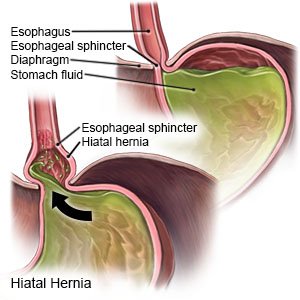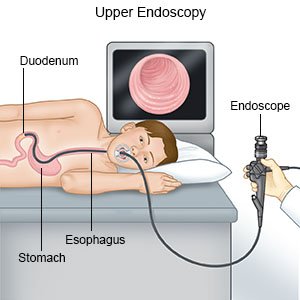Hiatal Hernia in Children
Medically reviewed by Drugs.com. Last updated on Jun 5, 2024.
A hiatal hernia is a condition that causes part of your child's stomach to bulge through the hiatus (small opening) in the diaphragm. This part of the stomach may move up and down, or it may get trapped above the diaphragm. Your child may have been born with a large or weak hiatus, or with the hiatal hernia.
 |
WHILE YOU ARE HERE:
Informed consent
is a legal document that explains the tests, treatments, or procedures that your child may need. Informed consent means you understand what will be done and can make decisions about what you want. You give your permission when you sign the consent form. You can have someone sign this form for you if you are not able to sign it. You have the right to understand your child's medical care in words you know. Before you sign the consent form, understand the risks and benefits of what will be done to your child. Make sure all of your questions are answered.
Nutrition:
A dietitian may talk to you about foods your child should avoid to manage heartburn. If your child continues to have trouble swallowing, a therapist may teach your child a safer way to swallow. The therapist will also tell you which foods and liquids are safe for your child to eat and drink.
An IV
is a small tube placed in your child's vein that is used to give medicine or liquids.
Medicines:
- Antacids decrease stomach acid that can irritate your child's esophagus and stomach.
- A histamine type-2 receptor blocker (H2-blocker) stops acid from being produced in the stomach.
- Promotility agents cause the esophageal sphincter to contract (tighten) more. The esophageal sphincter is the lower muscle of the esophagus.
- Proton pump inhibitors (PPIs) block acid from being made in the stomach.
Tests:
- An endoscopy uses a scope to see the inside of your child's digestive tract. A scope is a long, bendable tube with a light on the end of it. A camera may be hooked to the scope to take pictures.

- An upper GI series test includes x-rays of your child's esophagus, stomach, and small intestines. It is also called a barium swallow test. Your child will be given barium (a chalky liquid) to drink before the pictures are taken. This liquid helps your child's stomach and intestines show up better on the x-rays. An upper GI series may show an ulcer, a blocked intestine, or other problems.
- Esophageal manometry measures the pressure within your child's esophagus and stomach.
- Esophageal pH monitoring measures how much acid is in your child's stomach. A small probe is placed inside the esophagus and stomach to check the pH of your child's stomach acid. This test also measures the amount of acid that goes into your child's esophagus.
Treatment:
Surgery may be done when medicines cannot control your child's symptoms, or other problems are present. Your child's healthcare provider may also suggest surgery depending on the type of hernia your child has. A surgeon can put your child's stomach back into its normal location. The surgeon may make the hiatus (hole) smaller and anchor your child's stomach in the abdomen. Fundoplication is a surgery that wraps the upper part of your child's stomach around the esophageal sphincter to strengthen it.
Treatment options
The following list of medications are related to or used in the treatment of this condition.
- omeprazole
- famotidine
- lansoprazole
- aluminum hydroxide/magnesium hydroxide/simethicone
- aluminum hydroxide/magnesium trisilicate
RISKS:
Gastroesophageal reflux disease (GERD) caused by a hiatal hernia may lead to ulcers and bleeding in the esophagus. The hiatal hernia may also slide into your child's chest, get trapped, and not slide back into the abdomen. The tissue from the part of the stomach that is trapped may die if its blood supply is cut off. Your child may also have sudden severe chest pain and problems swallowing. This may lead to other serious health problems.
CARE AGREEMENT:
You have the right to help plan your child's care. Learn about your child's health condition and how it may be treated. Discuss treatment options with your child's healthcare providers to decide what care you want for your child.© Copyright Merative 2024 Information is for End User's use only and may not be sold, redistributed or otherwise used for commercial purposes.
The above information is an educational aid only. It is not intended as medical advice for individual conditions or treatments. Talk to your doctor, nurse or pharmacist before following any medical regimen to see if it is safe and effective for you.
Learn more about Hiatal Hernia
Treatment options
Care guides
Symptoms and treatments
Further information
Always consult your healthcare provider to ensure the information displayed on this page applies to your personal circumstances.
